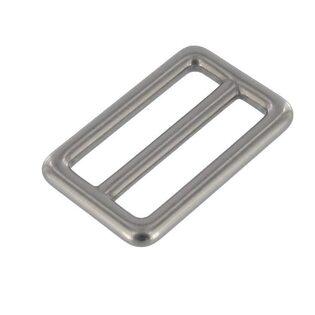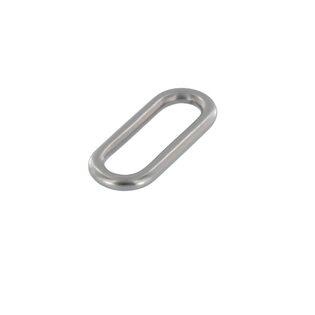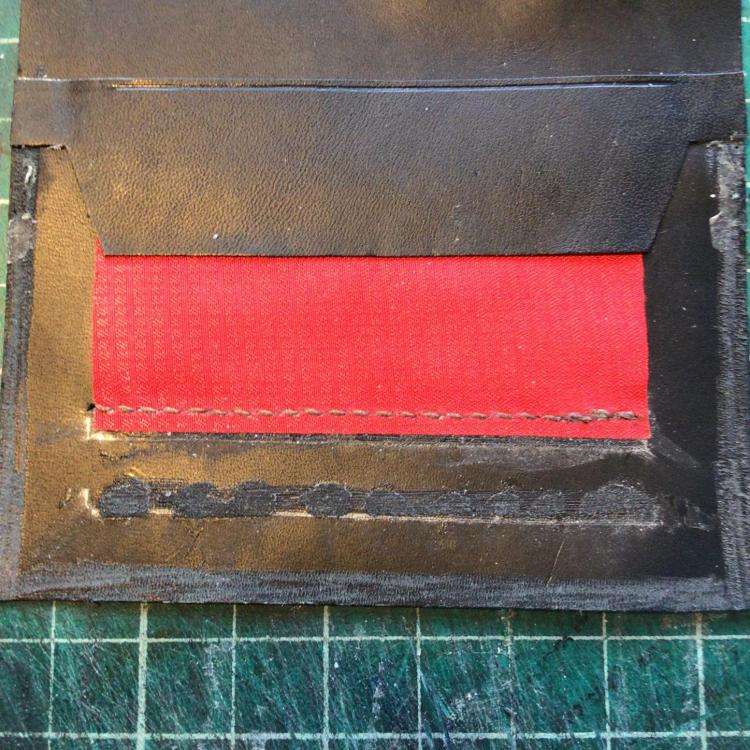
mike02130
-
Posts
512 -
Joined
-
Last visited
Content Type
Profiles
Forums
Events
Blogs
Gallery
Posts posted by mike02130
-
-
I like Uniters, followed by Vernis. I haven't used Fenice and I don't like Giardini paint but I do like and use their edge primer. It is more work to get a good edge with paint than it is burnishing veg tan.
-
What exactly are looking for? Size, shape and reason?
-
18 minutes ago, Piko said:
Yes I am definitely skiving it but not almost to zero.
Need a long tapered skive. Like I said earlier, show us a picture of the back of a T-pocket. Just make up a dummy one. In the meantime, I went into by box of shame and pulled out an example of what you were asking about material.
-
2 hours ago, Matt S said:
Another approach (which I prefer) is to use a thicker leather (say like your 2-3oz) and skive the hidden parts of the pocket to a feather edge. It needs some skill with the skiving knife but really reduces the apparent bulk of multiple stacked pockets and gives you a sturdy, chunky pocket top. It also gives you some flexibility with spongier-than-ideal bits of leather.
I agree with Matt S.
Your card holder has pronounced lines of the inner pocket. I wonder if you are skiving enough? You may want to go wider and taper it to almost zero. I don't think that's the case in your picture. I suggest you figure out this method before you go on to other types of pockets. You may receive better help if you were to show a picture of the back of one of your T-pockets. You may also want to upgrade from that Amazon knife in the picture.
-
This tape is not gummy compared to other tapes I've used. I've never used it for sewing so I can't give advice on that. With free shipping, it may be worth trying.
-
18 hours ago, YinTx said:
they want to know if I speak Spanish
No one asked you about Hatch chilies?
-
2 hours ago, fredk said:
There are many, many companies, not only leather suppliers but in other things as well, in GB who will just not send to N.I. Sometimes we are just a pariah
I'm curious to know why that is? Isn't N.I. part of the UK?
-
What type of wallet? Horizontal 9 pocket, vertical 6 pocket or something minimalist or card holder like? The more layers the thicker it gets. Do you plan on T-pockets? How about skiving? If you're burnishing then you must use veg tan. Does Springfield have much of a selection of thinnish veg? How much experience do you have making wallets? Are you OK with leather that is scarred or has other blemishes? Are you planning on all the wallets matching and using the same leather? Men's or Women's (unisex) wallets? The more concise the question, the better the answer.
I've tried the Korba and some colors look better than others. The red and black look nice. Rather than darkening they get smoother and shinier. The backs weren't bad but they ought to be burnished with Tokonole. There are nicer leathers available if you could bump your budget up to $150 to $200. If you figure how many square feet or there about per wallet, you could make a wiser decision of the type and amount of leather.
I line my wallets but if I were to make an unlined typical nine pocket bifold, I would use 1.5 mm for the back, 1 mm for the other side of the cash pocket and .8mm for the pockets. So that would be 2/3 and 3/4 ounces, I suppose. .
-
If you don't have experience then I suggest no lining. If you know what you're doing then use some nice leather and line it with some fancy goatskin. Maybe make a practice bag first. As long as you don't have any exposed metal hardware inside the bag then there ought to not be any worry about the laptop getting scratched.
The lining would be strictly for looks. But the bag itself should be of some quality in order to be up to par for the lining. You don't want to put lipstick on a pig, or in this case a cow.
You may want to be more specific in your question in order to get a better response.
-
-
1 hour ago, Danne said:
Yes, I think it’s mainly for dust collection
There's not much dust at all. It is more for the scraps or splits from the leather. Without a vacuum you need to reach into the bell and pull out what hasn't fallen out.
Say hej to my friend Erik Sörstedt if you see him.
-
Well, "Wild Harry" swears by a vacuum. I have one without a vacuum and I have no regrets. Like you, I use it for small projects like wallets, straps and purse gussets. I will sometimes run a 3' x 5mm strap through it and split it down to 3mm or so to make a shoulder strap for a purse. I'm familiar with your work and have read your posts and I don't think that you need to spend the extra money for a vacuum.
-
It just takes practice and a sharp blade. I hold on tight where there is always constant tension from the machine pulling and me counteracting it's pull.
-
I've used these before. It worked well.


-
I've been eyeing them on eBay. I don't know much about them but there are plenty of letters available.
-
9 hours ago, Spyros said:
How do you make holes for different size rivets, grommets, buckles, sam brownes, chicago screws etc without an appropriate punch?
And how do you set spring snaps, eyelets, double cap rivets, saddle rivets without a setter and a metal base?
I mean sure you can skip all that and only use the rivets that match your one size hole, and mash them with a hammer on the bench until they're flat, but in my mind that's kind of dumb to restrict yourself like that just for the sake of avoiding the proper tools.
The more you argue, the less sense you make. Like I said in the post that your comment is quoted from, Wallets, handbags and watch straps don't use all that hardware that you can not imagine living without. Perhaps you are just not aware of finer leather goods?
-
4 hours ago, Spyros said:
But I do disagree with your 100-200 euro tool list because there is the issue of leatherworking punches. You just need them from the get go, I can't think of anything else that will do, once you get to strap holes and hardware? The cheap ones break and the decent ones get pretty expensive pretty quickly because you do need different shapes and sizes. And then you need specific setters for every piece of hardware you choose to use (if you want to set it properly). A couple of irons, an awl, a cutting surface, a basic strap cutter, bevellers... I think the minimum starter budget is probably closer to $500.
A watch strap requires one hole punch. Wallets and most handbags don't require a punch unless you are making an adjustable shoulder strap; and then, it is only one punch. No "setters" are needed. So, 1 set of irons, and two punches is how much money? Hmm, you could even throw in a Japanese cutting/skiving knife and a creaser.
-
1 hour ago, fredk said:
This will really annoy the US members
I'm much in agreement with you, at least tools that were made in the last 25 years or so. Most US tools are made in Mexico and China. Milwaukee tools are owned by a Chinese company. I'm a finish carpenter (joiner) and woodworker so I have a lot of experience with wood tools. My tools are mostly older USA tools that are built well. I buy cheap broken USA power tools to use as replacement parts. My bigger machines are all USA made between 1950 to 1980. Many of my hand tools were made by Stanley from 1920 to the 1950's. There are small manufacturers in the USA that do make excellent tools. But no mass produced ones that I can think of. Many American professional tool users will agree with you. It is a topic often discussed on the job site.
I'm genuinely interested in knowing more about crappy USA tools and what tool brands and tool producing countries are preferred?
2 hours ago, fredk said:Tool dealers I know and have dealt with have long since stopped importing and after-sales supporting certain US made tools because of their poor quality.
-
On 10/7/2021 at 6:15 PM, sbrownn said:
because a country makes low cost products to fill a market niche doesn't mean that they are "shoddy" workmen.
I never made that claim.
On 10/7/2021 at 6:15 PM, sbrownn said:Maybe you should take a closer look at the environmental regulations that US corporations avoid by manufacturing in foreign countries.
I am aware of them.. I try damn hard to avoid buying from them.
On 10/7/2021 at 6:27 PM, sbrownn said:The Chinese were making high quality leatherwork 5000 years before America ever existed...do you think they have somehow have lost that skill set?
I don't believe the conversation was about leather goods, was it?
Your little polemic fails in so many ways. What is your point?
Some prefer quality over "quantity". I prefer quality. You seem to prefer mediocrity. Like they say, those who die with the most tools wins. How are those coal and wine and beef exports doing from your country? Go tell those workers your defense of buying low-cost imports and see what they say.
-
6 hours ago, thekid77 said:
hey Mike! I will have to try Ron's edger.....I've heard really good things about them
Yeah, I have a Palosanto #0, a Barry King #00 and Ron's #1. They are all the same size (hmm, go figure?). Keep in mind, if the leather is soft and floppy, no edger will do a proper job. I use Uniters edge paint on chrome tan and floppy veg tan.
-
The flesh side will get fuzzy with use. It does not get gummy.
-
For thin leather I use a Ron's #1 Montana edger. You could put the edge on top of something like a ruler or cutting mat so that the edge of the edger is not rubbing on the table. At that thinness, does it even need edging? But yes, sandpaper on a block would work. I sand diagonally to the edge.
-
3 hours ago, Klara said:
I wonder how the Chinese forum menbers feel about all this anti-China sentiment
I suggest you put your mind at ease and ask them. No one here is espousing anti-China sentiment. Rather it is that China is known for copying, counterfeiting and producing cheap inferior products and having shoddy working and environmental conditions. That is a fact.
-
On 9/29/2021 at 4:37 PM, tsunkasapa said:
It never DID. But much of it IS inferior garbage.
I Agree 100%. Money spent in the USA stays in the USA. At least most of it does. I'd rather spend my money close to home. It helps my neighbor buy food, pay their rent and send their kids to college. The money goes back into the American economy. Then there is the large dereliction of worker's rights and environmental regulations and the large carbon footprint of being made in China. Yes, it is nearly impossible to buy products not made in China, but I try my damndest. One is better off buying 40 year old used items that will outlast the newer imports. How about you UK guys that buy tools made in China that are labeled made in England? It is because they ship the finished tool to England and then Sheffield will attach a handle. How many Doc Martens employees lost their jobs when they started being Made in China? Australians--how about the job and quality losses from Blundstone moving to China? The landfills are full of cheap crap. I'm happier having fewer good items rather than a lot of crap items. By the way, none of what I said has anything to do with US China politics.


.thumb.jpg.dd4abae4a3dcb788a506f7dcfc549f02.jpg)
.thumb.jpg.7182b1e99441a56fd0b006cf9f70b7f2.jpg)

Font Sets for Hot Foil Machines
in Stamping
Posted
Me too. I've been eyeing the Kingsley's but only because they're plentiful on eBay. Any info would be appreciated.